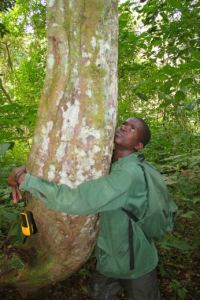Liana land
Author: Nadejda Josephine Msindai | Chimpanzee Researcher at Rubondo Island
The island is full of lianas, which are those woody vines Tarzan used to swing about on whilst in the jungle. We know of 7 species on Rubondo, but I am sure there are more. Unfortunately, little is known about lianas because only recently did plant biologists become interested in them.
Lianas ascend to the forest canopy using other plants as support. They have relatively little structural support and allocate more resources to reproduction and stem and root elongation. Lianas remain rooted to the ground throughout their lives and often have special adaptations to attach themselves to their host and climb into the forest canopy. These adaptations include stem twining, clasping tendrils arising from stem, leaf and branch modifications, thorns and spines that attach the liana to its host, downward-pointing adhesive hairs, and adhesive, adventitious roots.
Lianas proliferate in canopy gaps and on top of the trees in the forest canopy. On Rubondo, lianas are abundant which partly explains why the island does not have a closed canopy forest. Because in gaps lianas can be extremely abundant and are able to block the development and closure of the forest gap, impeding the regeneration of seedlings and saplings of forest trees.
Lianas have a particularly strong impact on the trees that they climb. Trees that are being climbed by lianas can undergo severe constriction, which may have strong negative impacts on water and sap movement in the tree. Prolonged constriction by lianas may finally lead to the death of the host tree. Lianas also compete with trees for water, nutrients and light.
Follow Josephine’s experiences conducting research on her blog Chimpanzee Letters
![]()





































